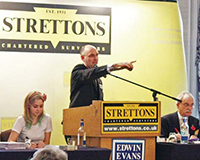Strettons managing director Ben Tobin finds echoes of today’s market in the history of the auction house
2016 marks Strettons 85th birthday. While some companies, especially – dare I say it – some of the pop-up online auction houses, measure “time served” in months rather than years, it is difficult to dispute that being established for three generations is something to be proud of, as are long-standing relationships with clients.
And many people would argue that auctions and the property market have not changed much over the years.
My uncle, Jack “Stretton” Tobin, and his brother Sidney – my father – were only 21 and 18 when they set up Strettons in 1931. They started with one office in Hackney, E5. This was shortly followed by a second in Leyton, E10, (which later changed to Walthamstow, E17).
It was a time of adversity, in the midst of the Great Depression, with UK unemployment reaching 3m: a rate of about 7%. Nevertheless, as we know from our most recent recession, the more difficult the times, the more clients need advice. While property ownership may have been less achievable for most people in the 1930s, there were still people trying to make money from property during a downturn. With extremely low interest rates, many people saw property as the best investment.
Our first recorded public auction was on 27 May 1937. We still have a poster in the office showing that it was for a freehold investment of 10 dwelling houses in Manor Park, E12, producing £577 and 4 shillings a year, at a time when the typical wage for a family man was 35 shillings and thruppence. Property, especially in London, is as unaffordable to the average person in 2015 as it was in 1937, especially with it becoming increasingly difficult for buyers to get finance following the recession.
We continued to develop our auction side of the business but the Second World War changed the landscape of the property industry; although it didn’t come to a standstill, priorities changed. When my father went off to war, his older brother soldiered on at home in a designated wartime occupation as a surveyor, dealing with countless war damage claims.
We have two letters from this period – one to Jack, dated 22 May 1941, from an army chaplain in North Africa who was also a client of the firm, saying that he had visited Sidney in hospital where he was recovering from wounds. The other is from a member of the House of Lords dated 23 June 1949, naming Sidney Tobin of Strettons as the person “who arranges the whole of my war damage work”.
Strettons’ library still contains war damage claims books, which we dusted off recently when an unexploded 500lb bomb was found in a property we manage in east London.
After the war, we were kept busy dealing with slum clearance compensation cases, which effectively laid the foundations for a “New Britain”. My cousin Peter and I were still dealing with the latest of these CPOs in the late 1970s when I joined the firm.
From humble beginnings in the 1930s, Strettons now has five offices and more than 110 staff. I am not sure what our two founders, who are no longer with us, would make of today’s world, far away from Gestetner duplicating machines, typewriters, telephone exchanges with cables and plugs and the luxury of a “frothy coffee”.
Our work has spread much further afield and, in the past 10 years or so, there has also been a marked change in our “patch”, where we now have the largest shopping centre in Europe, Olympic-standard venues, and Silicon Roundabout, to name but a few.
We still hold an auction every eight weeks and we continue to retain some of the traditions of printing a catalogue and holding the auction open to the public in a central London location. But, with an eye to the future, we use digital technology and have an online auction facility.
As to whether online will supersede the room, I have my doubts, but I suspect and hope there will be a place for both. By working symbiotically in a market where auctions represent only 2% of UK properties sold each year, we auctioneers offer an acceptable alternative to private treaty.
We can use all sorts of statistics to define and analyse the property market and particularly auctions but, since I first stood on the rostrum in 1978, I have met countless people, each with an interesting property story to tell, which reminds me this sector isn’t just a numbers game.












